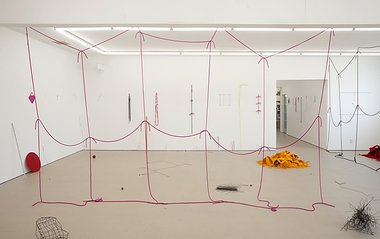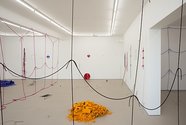John Hurrell – 13 February, 2017
This range - from small heaps of saturated coloured felt, to angular formations of tumbling spidery wires spilling off the wall, and giant floppy nets or funny ‘shouting' stick figures on the floor - reveals Robinson at his most restless, but not wildly frenetic or dense like some of his riotous late nineties installations. It is all tightly ordered. The threaded-together or heaped felt works, with their intense hues and intricate minute punched-out forms, still dominate, especially with the glowing floor piles and smaller (quite complex) sagging grids on the walls. They are breathtaking.
A solo show where he mixes his trademark die-cut felt with many other materials, Peter Robinson’s After Party displays the linear properties of threaded (compressible) felt but now presented alongside suspended wire, crumpled paper, plastic straws, rubber loops, metal blocks, Plasticine balls, cut Perspex, pieces of carpet, cardboard boxes and more. Using pieces of snipped off, thin weedy wire carefully placed on the floor, drooping felt grids, and so on, Robinson presents an assortment of ‘drawings’ on the floor, along the walls and in the midst of airy, free-wheeling, light-drenched space so you can look through - the latter referencing cognitive sorting processes.
This range - from small heaps of saturated coloured felt, to angular formations of tumbling spidery wires spilling off the wall, and giant floppy nets and funny ‘shouting’ stick figures on the floor - reveals Robinson at his most restless, but not wildly frenetic or dense like some of his riotous late nineties installations. It is all tightly ordered. The threaded-together or heaped felt works, with their intense hues and intricate minute punched-out forms, still dominate, especially with the glowing floor piles and smaller (quite complex) sagging grids on the walls. They are breathtaking.
However Robinson’s spindly wire hangings are so delicate with their delicious wobbly lines and tremulous demeanour, that they almost upstage the soft matrixes. He has taken the wire from early Tuttle but made it less precious and gruntier, and more akin to Brice Marden. These pieces of linear metal are bent to hook onto each other - to make chains - and so we see a method of assembled portable line explored on the vertical planes, while on the flat horizontal one, straight wires positioned to link up to form arrows or projecting bushes simply use gravity. Some of the stick figures seem to be jokes about himself being a teacher, yelling at students while waving a big stick. Others are asides about ocular perception from psychology textbooks.
There is much to discover for the patient and careful observer in this airy but indisputably rich show, from the bent metal tubes whacked into shape with a heavy sharp blade, to purple coloured felt diamonds hanging on the wall with smaller shapes jammed into their negative spaces. Laden with multiple references to other artists like Martin Creed (screwed up paper balls) or Tom Kreisler (the undulating lines of his coat paintings) this is an absorbing exhibition that only occasionally gets repetitive as if done by rote, on automatic pilot. A thrilling celebration of cut-out colour, line and texture, mingled with the wondrous processes of tumbling gravity and delineated order.
John Hurrell



 Two Rooms presents a program of residencies and projects
Two Rooms presents a program of residencies and projects Advertising in this column
Advertising in this column



This Discussion has 0 comments.
Comment
Participate
Register to Participate.
Sign in
Sign in to an existing account.